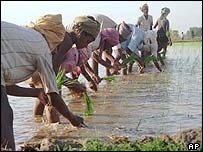PREAMBLE: On June 25, 2009, the Economist published "A slow-burning fuse: A special report on ageing populations”, drawing significantly from recently released estimates from the International Monetary Fund (IMF). The Economist report is available online at http://www.economist.com/specialreports. It begins with a focus on rapid aging trends in rich countries, and affirms that low-income countries are only a few decades behind. For a direct link to the report, go to http://tinyurl.com/kw7bvh
We selected this topic for the August issue of Global Perspectives not only because of its importance world-wide, but also because – in our teaching, publishing and advisory roles – we (among others active in the population health sciences) have been stressing the relevance and impact of ageing to the health of populations for over two decades. By way of historical interest, the following references to two early publications are listed:
White F, The Environment of Medicine in the 21st Century: implications for Preventive and Community Approaches. Canadian Medical Association Journal 1987, 136: 571 75.
White F, Prevention of Disease and Promotion of Health An Overview of Medical Education in Canada, Association of Canadian Medical Colleges. ACMC Forum, 1987, XX, 2:1 3,6.
We are pleased to note that appropriate attention is finally being given to these demographic forces and effects by widely established media sources such as the Economist. Their ability to present the phenomenon in common (non-technical) language, placing it in the perspective of the global financial crisis (that affects everyone), and then highlighting what the future may hold, should be a wake-up call to governments around the world: to come to grips with the policy and fiscal implications.
What we reflect below is a précis of some key points; interested readers should consult the complete article which includes several charts to illustrate the main observations.
REVIEW OF “A slow-burning fuse”
The special report places the current deep recession, trillion-dollar rescue packages and burgeoning job losses within an even more sobering perspective. It contemplates the longer term consequences of demographically ageing populations: the prospects of slow growth, lower productivity, rising public spending and labour shortages.
In June 2009 the IMF released its estimates of the impact of the current financial crisis. The costs will be huge: the fiscal balances of the G20 countries will likely deteriorate by 8 % of GDP in 2008-09. However, they also noted that in the longer term these costs will be dwarfed by age-related spending. Between now and 2050, it predicted that “for advanced countries, the fiscal burden of… ageing-related costs” will be about 10 times greater than this, mostly due new spending on pensions, health and long-term care.
The report notes that the rich world’s population is ageing fast, and that the poor world is only a few decades behind. According to the UN’s latest biennial population forecast, the median age for all countries is due to rise from 29 years now to 38 years by 2050. At present just under 11% of the world’s 6.9 billion people are over 60. Taking the UN’s central forecast, by 2050 that share will have risen to 22% (of a population of over 9 billion), and in the developed countries to 33% (see the Economist’s chart 2). Put another way, in the rich world 1 person in 3 will be a pensioner; nearly 1 in 10 will be over 80. This is a relentless development that in time will have vast economic, social and political consequences. By about 2020, barring huge natural or man-made disasters, demographic changes are much more certain than other long-term predictions (even climate change).
So what is making the world so much older?
There are two long-term major causes, plus a “temporary blip”.
The first major cause is that people everywhere are living far longer than they used to: in 1900 average life expectancy at birth for the world as a whole was only around 30 years, and in rich countries under 50. The figures now are 67 and 78 respectively, and still rising. We agree with the Economist that this is something to be grateful for - especially since older people these days also seem to remain healthy, fit and active for much longer.
A second, and much larger, cause of the ageing of societies is that people everywhere are having far fewer children (declining fertility rates), so that younger age groups are too small to counterbalance the growing number of older people. This trend emerged first in developed countries and is taking place now in poor countries too. In the early 1970s women across the world were still, on average, having 4.3 children each. The current global average is 2.6, and in rich countries only 1.6. In many less developed countries the rates are still in the range of 3-6, but steadily falling. The UN predicts that by 2050 the global figure will have dropped to just 2 (2.1 is often taken as the level for zero population growth, independent of migration), so by mid-century the world’s population will begin to level out. The numbers in some developed countries have already started shrinking. As the report argues, this will certainly turn the world into a different place.
The temporary blip that has magnified the effects of lower fertility and greater longevity is the baby-boom that arrived in most rich countries after World War II. The timing varied slightly from place to place, but in North America it covered roughly the 20 years from 1945. The first “baby boomers” are now approaching retirement. For the next 20 they will swell the ranks of pensioners, and lead to a decline in the working population.
In richer parts of Asia e.g, Japan, South Korea, Taiwan, populations are already old and will become even older. Europe is split: Germany, Italy and Spain now have tiny families and are therefore ageing fast, whereas France, Britain and most Nordic countries have more children which keeps them younger. In eastern Europe, and particularly in Russia, birth rates are low and life expectancy has also taken a knock. North America, due to a resilient birth rate and high immigration, will remain fairly youthful by mid-century.
In most developing countries, although birth rates are dropping, populations will remain relatively young for decades yet. But in the longer term demographic dynamics will cause poorer countries to age too. Before then, the absolute numbers of older people will swell substantially, simply because these countries are so populous. The current total of 490m over-60s, will more than triple by 2050. Since most poor countries have little or nothing in the way of a state-funded welfare net, those numbers will be hard to manage.
Alone among developing countries, China is already ageing fast. For the past 30 years it has been keeping a tight lid on population growth: not quite the “one-child policy”, as it is often called (the average number of children per woman was closer to 2), the population will peak at about 1.46 billion in 2030 and then decline. Although China has seen stupendous economic growth in recent years, it will be challenged by the cost of absorbing the cost of this rapidly ageing population.
The report also addresses the macroeconomic impacts: “as more people retire, and fewer younger ones take their place, the labour force will shrink, so output growth will drop unless productivity increases faster. Since the remaining workers will be older, they may actually be less productive.” The implications for financial markets also receive comment in the report, along with speculations regarding the potential for declining standards of living related to such issues as reduced savings rates, and asset depletion. The OECD estimates that over the next three decades the age-related decline in the labour force could cut growth in its member countries by a third compared with the previous three decades.
Envoi:The following two paragraphs are quoted verbatim, as they seem to sum up the implications not only for health but also for social policy:
“For the public finances, an ageing population is a huge headache. In countries where public pensions make up the bulk of retirement income, these will either swallow up a much larger share of the budget or they will have to become a lot less generous, which will meet political resistance (and remember that older people are much more inclined to vote than younger ones). Spending on health, which in most rich countries has been going up relentlessly anyway, is likely to grow even faster as patients get older. And because of a huge increase in the number of over-80s, a lot more money, and careful thought, will be needed to provide long-term care for them as they become frailer.
What can be done? As the IMF puts it, 'the fiscal impact of the [financial] crisis reinforces the urgency of entitlement reform.' People in rich countries will have to be weaned off the expectation that pensions will become ever more generous and health care ever more all-encompassing. Since they now live so much longer, and mostly in good health, they will have to accept that they must also work for longer and that their pensions will be smaller.”
Source: A Special Report on Ageing Populations - A slow-burning fuse. Jun 25th 2009 Economist.com. http://www.economist.com/specialreports/displayStory.cfm?story_id=13888045
FROM a Great Canadian and World Statesman
"A great gulf... has... opened between man's material advance and his social and moral progress, a gulf in which he may one day be lost if it is not closed or narrowed..."
Lester B Pearson
http://nobelprize.org/nobel_prizes/peace/laureates/1957/pearson-lecture.html
Monday, 17 August 2009
THE GLOBAL ECONOMIC, HEALTH & SOCIAL IMPACTS OF AGEING POPULATIONS
INSPIRATIONAL WELCOME ............................... from T.S.Eliot's "Little Gidding"
If you came this way From the place you would come from... It would be the same at the end of the journey...
If you came, not knowing what you came for, It would be the same... And what you thought you came for Is only a shell, a husk of meaning... From which the purpose breaks only when it is fulfilled If at all.


























